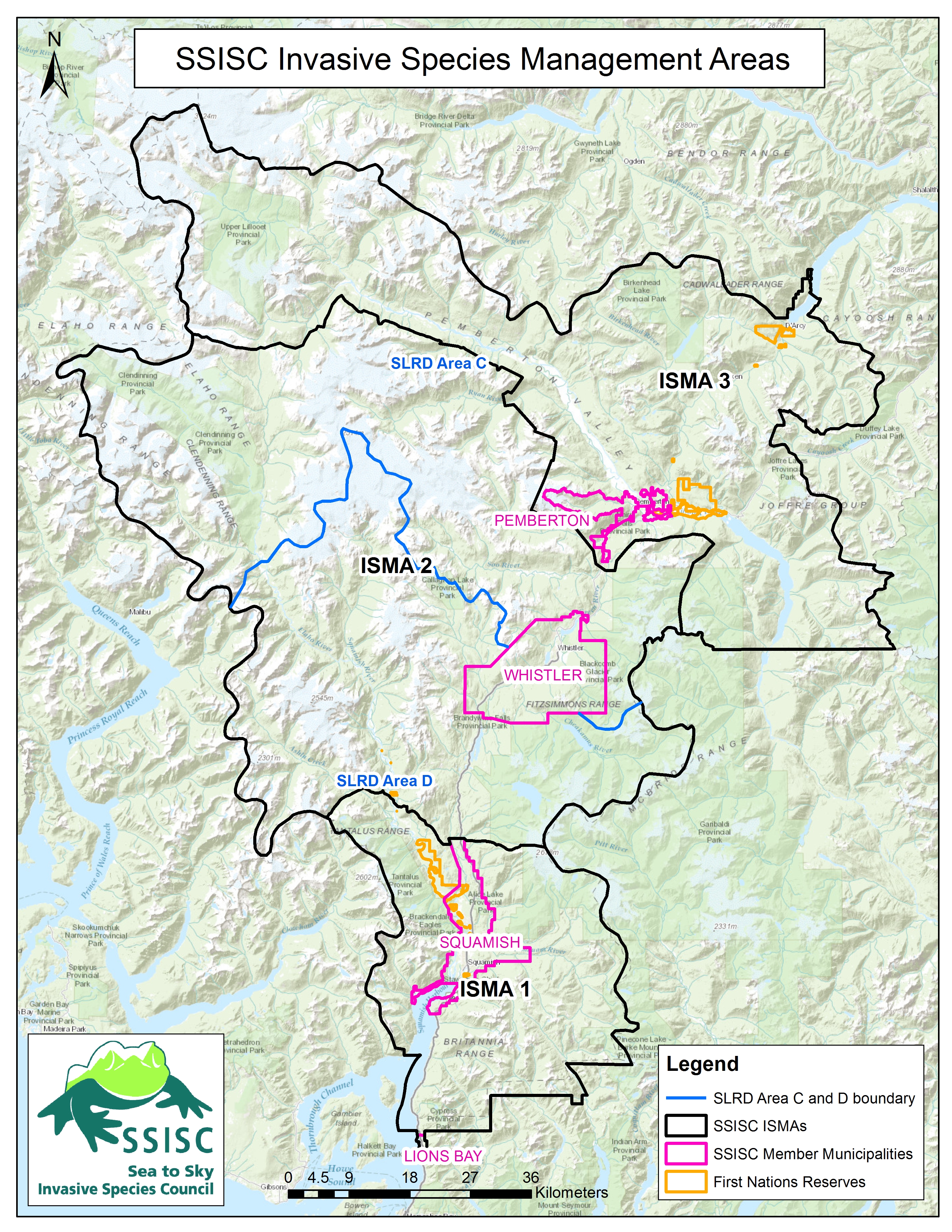Our Approach
SSISC’s approach to invasive plant management is to work closely with landowners and managers across the region to develop site and species-specific management plans, including annual workplans and site lists.
Our actions are guided by an integrated pest management approach, the South Coast Mainland Invasive Plant Pest Management Plan for Provincial Crown Lands, best management practices such as those prepared by Metro Vancouver, as well as other rules and regulations.

Invasive Plant Management
What kind of work do we do for invasive plants?
The Sea to Sky Invasive Species Council’s Field Crew manages invasives by carrying out:
- Inventory
- Manual Control
- Chemical Control
- Biological Control
- Monitoring
The core of our invasive plant management work is carried out from April to October, however, some evergreen species can be spotted and controlled year round.
We rely on you: more eyes on the ground reporting sightings, helps us and our partners to catch infestations earlier and ultimately fight the spread of invasives more effectively.
Inventory
The first step in any invasive species management plan is to complete an inventory. Knowing what invasive species exist and where they are located are essential when setting priorities for taking action.
Inventory involves a visual inspection of a site, to record the presence or absence of invasive plant species. When SSISC staff conduct invasive plant inventories, we record detailed information about which species are observed, the spatial extent of the plants present, as well as descriptors of the distribution and density.
Maps created using inventory data are used to inform plans for control.
Invasive plant inventory records collected across British Columbia are submitted to a public database – the Invasive Alien Plant Program (IAPP).
Manual Control

Where possible and feasible, control work is done manually. Manual control strategies include pulling, cutting, digging, mowing and excavating.
Chemical Control
For some extremely aggressive and destructive invasives, such as Japanese knotweed, the best approach is to apply herbicide.
Chemical or Herbicide control options include:
- Stem injection
- Cut and fill, and
- Backpack foliar spray.
All herbicide control work done by SSISC is completed by Certified Pesticide Applicators, under our Pesticide Use Licence.
If you are interested in learning more about practical herbicide application techniques for high-priority invasive plants in the Sea To Sky region, we offer Best Practices Field Training sessions for Certified pesticide applicators upon request.

Biological Control

SSISC also carries out monitoring for biological control agents, as part of the Province of BC’s Biocontrol Program.
The objective of this program is to reduce invasive plant populations to ecologically and environmentally acceptable levels, and to prevent invasive plants from spreading to new areas. Biocontrol is part of an integrated pest management approach.
It is worth noting that biological control alone will never eradicate an invasive plant; rather, the goal is to suppress its population to allow the native plant community to regain vigour. Still, as the biocontrol agent’s population increases or decreases, the targeted plant species’ population will follow due to the increased or diminished supply of food, or conversely, feeding pressure.
Monitoring
Invasive species management is a multi-year process requiring an integrated approach.
Complete eradication of an invasive species infestation typically does not occur after the first year of manual or chemical control, due to a number of factors. Even in perfect conditions, and when control efforts are carried out precisely and effectively, you can expect that treatments will need to be repeated, often multiple times, to achieve eradication. A few ways that invasives demonstrate resilience to control efforts include:
- a long-lasting seed bank in the soil;
- late-emerging plants;
- the ability to regrow from a small section of stem or root; and
- tolerance to herbicide.
For this reason, SSISC monitors control efforts following provincial standards and enters data into the Invasive Alien Plant Program (IAPP) database. This allows SSISC to assess the progress and effectiveness of control efforts in our region. The information is then used during future decision-making in order to maximize the efficacy of future control efforts.
Prioritization
At SSISC, we prioritize what species are controlled and where we work based on a Regional Strategy and Operational Plan. Both are updated by the SSISC’s Staff and Board of Directors, in collaboration with key partners and stakeholders, every 5 years. Because the Sea to Sky region is comprised of several communities with different geography, habitats, land uses, vectors of spread, and values, we divide the region up into 3 Invasive Species Management Areas (ISMAs) for our operations.

How You Can Help
Your help in identifying new infestations is extremely important to us. You can help SSISC control the spread of invasive plants in the Sea to Sky by learning how to identify invasive plants, and reporting any sightings.
If you need help with an invasive plant management project, the SSISC crews are available for hire. Please contact us at info@ssisc.ca to find out more about our fee-for-service program.
Additional Links
- Cooperation and collaboration with many stakeholders and funders: Yellow-Flag Iris Removal – Wetland and Riparian Habitat Restoration in Whistler





